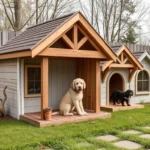
When it comes to caring for our furry friends, few items are as essential as dog cones, also known as Elizabethan collars. These collars serve a vital purpose in ensuring that pets do not interfere with their healing process, whether due to surgery, skin conditions, or allergies. While traditional dog cones serve their function, many pet owners are discovering the value of DIY dog cones—solutions that are not only cost-effective but customizable and often more comfortable for our pets.
In this guide, we’ll explore the purpose of dog cones, the benefits of creating your own, materials you can use, and step-by-step instructions to help you craft the perfect cone for your pup.
Understanding Dog Cones
Purpose of Dog Cones
Dog cones are primarily designed to prevent pets from accessing wounds or surgical sites. After operations, dogs may instinctively lick or scratch at their stitches, which can lead to infections or complications. Additionally, dog cones are useful in managing skin conditions and allergies, helping to keep your pet from irritating sensitive areas.
Types of Dog Cones
There are several types of dog cones available on the market, each with its advantages and disadvantages:
- Traditional Plastic Cones (E-Collars): These rigid cones are the most common and effective in preventing pets from reaching their wounds.
- Inflatable Collars: These collars resemble a doughnut and allow for more comfort while still preventing access to injuries. However, they may not be as effective as traditional cones for all pets.
- Soft Fabric Cones: Offering a more comfortable fit, these cones can be less restrictive. However, they may not provide the same level of protection as plastic cones.
Understanding the various types of dog cones available is crucial in determining which option is best for your pet’s needs.
Benefits of DIY Dog Cones
Cost-Effectiveness
One of the most appealing aspects of DIY dog cones is their cost-effectiveness. Purchasing a cone from a pet store can be quite pricey, especially if you have a larger dog or need multiple sizes. By creating your own, you can significantly reduce costs, often using materials you already have at home.
Customization
Another significant benefit of DIY solutions is customization. Each dog is unique, and a one-size-fits-all approach can often lead to discomfort. With DIY dog cones, you can tailor the size and design to fit your dog’s specific needs, ensuring a more comfortable experience. You can even incorporate personal styles or pet preferences, making the cone a bit more appealing.
Environmental Impact
Creating DIY dog cones also allows you to consider the environment. By utilizing recycled materials, you’re not only saving money but also reducing waste from single-use products. This eco-friendly approach can make a positive difference in your household and beyond.
Materials Needed for DIY Dog Cones
Common Household Items
Many items around your house can be repurposed into a dog cone. Here’s a list of common household items:
- Cardboard: Sturdy and easy to cut.
- Old T-shirts: Can be fashioned into soft cones.
- Plastic bottles: Can be cut and shaped to create a protective barrier.
When choosing materials, always consider safety. Make sure they are non-toxic and do not pose a choking hazard.
Specialty Items
If you want to enhance your DIY dog cone further, you might need to source some specialty items:
- Fabric: Soft, breathable materials can provide extra comfort.
- Padding: Foam or soft fabric can help prevent chafing.
- Adjustable Straps: Velcro or elastic bands can help secure the cone comfortably around your dog’s neck.
You can find these materials at craft stores or online marketplaces at affordable prices.
Step-by-Step Instructions for Making DIY Dog Cones
Basic DIY Dog Cone Design
To create a simple cardboard cone, follow these steps:
- Measurements: Measure the circumference of your dog’s neck and the length from the neck to the tip of the nose.
- Cut the Cardboard: Use a piece of cardboard large enough to accommodate your measurements. Cut a circular piece out for the base and a cone shape for the collar.
- Assembly: Tape or glue the cone to the base securely.
- Adjustments: Ensure it fits snugly but comfortably around your dog’s neck, making adjustments as necessary.
Soft Fabric Cone Method
For a more comfortable option, you can make a soft fabric cone:
- Materials Needed: Gather soft fabric, a sewing kit, and padding.
- Measurements: Measure your dog’s neck and nose length.
- Cut the Fabric: Cut out a circular base and a cone shape from the fabric.
- Sewing Instructions:
- Sew the edges of the cone to prevent fraying.
- Attach padding along the inner edge for comfort.
- Sew the base to the cone securely.
- Adjust Fit: Use adjustable straps made of fabric or Velcro to ensure a snug fit.
Inflatable Collar DIY
For an inflatable collar option, you’ll need:
- Materials Needed: An inflatable pool ring and a fabric cover.
- Modification Instructions:
- Cut the fabric into a circular shape that can encase the pool ring.
- Sew or secure the fabric around the ring, leaving openings for air.
- Pros and Cons: Inflatable collars can be more comfortable but may not provide as much protection as traditional cones, so monitor your dog closely.
Customized Designs
To add a personal touch, consider decorating your DIY dog cone:
- Use fabric paint to create patterns.
- Attach patches or embellishments to make it visually appealing.
- Incorporate additional padding or support features to enhance comfort.
Ensuring Comfort and Fit
Proper Sizing
Achieving the perfect fit is crucial for your dog’s comfort. Measure your dog’s neck correctly and always leave a few extra inches for adjustments. An adjustable design will help accommodate any changes in your dog’s size.
Enhancing Comfort
To make your DIY dog cone more comfortable:
- Add soft padding around the neck.
- Choose breathable materials to prevent overheating.
- Ensure there are no sharp edges or irritating seams.
Monitoring Your Dog’s Reaction
Keep an eye on your dog after fitting the cone. Signs that the cone is fitted correctly include:
- Your dog can move comfortably without restrictions.
- They are not trying to paw or remove the cone.
If your dog shows signs of discomfort, such as excessive whining or trying to escape the collar, reassess the fit and consider adjustments or alternative designs.
Alternatives to Traditional Dog Cones
Recovery Suits
Recovery suits are an increasingly popular alternative to traditional dog cones. These suits cover the dog’s entire body, preventing access to wounds while allowing for more freedom of movement. Pros include:
- Increased comfort and less restriction.
- Easier to put on and take off compared to cones.
However, they may not be suitable for all types of injuries, so consult with your veterinarian.
Other DIY Alternatives
If a cone isn’t a viable option for your dog, consider other DIY solutions:
- T-shirt Method: An old t-shirt can be fashioned into a makeshift recovery suit to cover wounds.
- Scarf or Bandana: Tying a scarf around the waist can deter licking in some cases.
Always ensure any alternative solution is effective and safe for your dog’s recovery.
Conclusion
In summary, DIY dog cones offer an innovative and practical approach to pet care. They not only save money but also provide a customized solution that caters to your pet’s unique needs. Whether you choose to create a traditional cardboard cone, a soft fabric alternative, or an inflatable collar, the goal remains the same: to ensure your furry friend’s comfort during their recovery process.
With the right materials and a little creativity, you can craft a cone that not only does its job but also reflects your pet’s personality. Embrace the DIY spirit and give your dog the comfort they deserve while they heal.
FAQs
How long should a dog wear a cone?
Generally, dogs should wear a cone until their wounds have fully healed, which can range from a few days to a couple of weeks, depending on the severity of the injury or surgery. Always follow your veterinarian’s advice.
Can dogs eat and drink with a cone on?
Yes, most dogs can eat and drink while wearing a cone, though it may take some adjustment. Consider using shallow bowls to make it easier for your dog.
What to do if my dog refuses to wear a cone?
If your dog is resistant, try adjusting the fit, using a softer material, or introducing the cone gradually. Alternatives like recovery suits or other DIY solutions can also be effective.
Are there any risks associated with DIY dog cones?
While DIY dog cones can be safe, it’s essential to ensure that they are made from non-toxic materials and that there are no sharp edges. Regularly monitor your dog to ensure the cone remains comfortable and effective.
With proper care and a little creativity, you can create a DIY dog cone that meets your pet’s needs while keeping them safe and comfortable.









